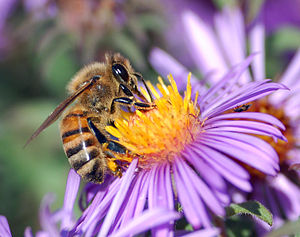Welcome back to our gardening series!
This article is the second in a series designed to help those interested in starting your own
sustainable garden. Whether you are working with limited space, or have a large area available, whether you are interested in fruit, vegetables, or flowers, I hope you will find these tips helpful.
This week we are going to cover the first step in the process:
 Image via WikipediaDecide What Type Of Garden You Want
Image via WikipediaDecide What Type Of Garden You Want
If you’re thinking about starting a garden, the first thing you need to consider is what type of garden you want. There are many different choices and often it can be hard to pick just one, but hopefully these tips can help narrow it down. By narrowing it down, you’ll make the gardening experience easier on both yourself and the plants. If all your plants are similar in type, then it shouldn’t be very hard to care for them all. So here are some of the main garden ideas for you to choose from.
Flowers
If you’re just looking for something to look pretty in your yard, you may want to consider want a flower garden. There are a couple of different families of flowers available for your new garden. Perennial flowers are flowers which come back year after year. Different areas and climates have different flowers which are considered perennials.
Annuals are flowers which must be planted every year — usually in the spring, although this also will depend on your climate and location.
If you do a quick internet search for your area, you can probably find a list of flowers that will bring your new garden to life. Flowers are generally fairly easy to grow, since they often require the most work in the planting stage – after that, they usually can take care of themselves to some extent.
Vegetables
Another choice for your new garden is a vegetable garden. These usually require a
 Image via Wikipedia
Image via Wikipedialittle more work and research than a flower garden, but can be much more rewarding, as they can help you put food on the table! Depending on your climate, you may be able to produce vegetables in your garden for most of the year.
When starting a vegetable garden, you should build it with the thought in mind that you will be adding more types of veggies in later. This will help your expandability. Once all your current crops are out of season, you can rotate in new and different crops. This type of planning works very well for those with limited garden space. A vegetable garden is ideal for someone who wants some produce, but doesn’t want to devote every waking hour to perfecting their garden (see below.)
Fruit
One of the more difficult types of gardens to manage is a fruit garden or orchard. It’s definitely the most high-maintenance! When growing fruits, many more pests will be attracted due to the sweetness of the fruit. You’ll not only have to deal with having just the right dirt and fertilizer, you have to deal with choosing natural pesticides which won’t pose a health-risk to those eating the fruit.
Your fruit garden will probably not produce fruit year-round. The soil needs to be just right for the plants to grow, and putting in another crop during its off-season could be difficult, or even disastrous to its growth process. But if you’re willing to put lots of work into maintaining a garden which gives sweet rewards, then a fruit garden could be a good choice for you.
So now that I’ve outlined some of the main garden types that people choose, it’s time to spend a little time considering your decision. Basically, the garden type comes down to what you want to get out of it, and how much work you want to put into it. If you’re looking for a lovely looking garden with little work, go with a flower garden.
If you want to grow lots of delicious produce, and are willing to put in more time and effort, then go for a vegetable or fruit garden.
Just be sure this is something that you are going to enjoy doing — otherwise, it won’t be worth it for you to put in the effort involved.
In the next article in this series, we will discuss how to choose the best location for your new garden.
And as always, you can find more sustainable gardening tips and resources on our main website at
http://www.newholisticliving.com/sustainablegardening.html.
See you next time!
Rose.













